Posted by: Northwest Eye in General on June 22, 2025
Overview
The article ‘7 Key Insights on Lump on Eyelid Cancer for Early Detection’ highlights the crucial role of recognizing symptoms and seeking timely medical intervention for eyelid cancer.
We understand that facing health concerns can be daunting, but it’s important to know that early detection can significantly improve treatment outcomes.
Particularly for basal cell carcinoma, which boasts a high cure rate of over 95% when diagnosed and treated promptly, the statistics and expert opinions shared in this article reinforce the importance of acting quickly.
Remember, we are here to help you through this process.
Introduction
Understanding the nuances of eyelid cancer is crucial, especially as we see a rise in cases of lumps on the eyelid. We recognize that this can be a worrying time, but advancements in detection and treatment mean that early intervention can significantly enhance outcomes, offering hope to those affected. Yet, it’s common to feel uncertain about the warning signs or the importance of regular eye exams.
This raises a pressing question: how can one effectively navigate the complexities of eyelid cancer detection and treatment to ensure the best possible prognosis?
This article delves into seven key insights that illuminate the path to early detection and informed care, empowering you to take control of your eye health. We are here to help you through this process.
Northwest Eye: Comprehensive Care for Eyelid Cancer
At Northwest Eye, we offer a comprehensive range of eye care services, including specialized care for patients with a lump on eyelid cancer. With over 50 years of experience, our clinic utilizes advanced methods and cutting-edge technology to ensure optimal outcomes for individuals like you. Our team of experienced eye surgeons is dedicated to providing customized care tailored to your unique needs. We understand that being diagnosed with a lump on eyelid cancer can be daunting, and we are here to ensure you receive the finest quality of assistance and support throughout your journey.
An essential part of our approach is the Be Eye Wise initiative, which emphasizes the importance of understanding eye health and care options. Recent advancements in the treatment of eyelid malignancy, including innovative surgical techniques and targeted therapies, have significantly improved outcomes for those affected by lump on eyelid cancer. Many individuals have experienced successful recoveries, and we are committed to continuous education and research in eye tumor management. This dedication positions us as a leader in the field, ensuring you benefit from the latest advancements in treatment while empowering you to make informed choices about your well-being.
- “Great place. The doctors and staff were extremely patient with our very active 15-month-old daughter.” – Lydea L
- “All of the staff at Northwest Eye are friendly and get your needs taken care of in the best of ways. A visit to any of the clinics is a great experience.” – Perry H
- “Always professional, prompt, and helpful with explanations and procedures.” – Mary Ann M
We invite you to learn more about the Be Eye Wise initiative and schedule an appointment by visiting our website. We are here to help you through this process.
Types of Eyelid Tumors: Understanding the Variants
Eyelid tumors can be classified into benign and malignant types, and we recognize that a lump on eyelid cancer can be particularly concerning. Basal cell carcinoma (BCC) is the most prevalent, accounting for approximately 69.8% of malignant eyelid tumors, while squamous cell carcinoma (SCC) follows as the second most common type. Other less frequent malignancies include sebaceous gland carcinoma and melanoma. Comprehending these variants, such as a lump on eyelid cancer, is crucial for early detection and efficient care, as each type exhibits distinct characteristics and management needs.
It’s common to feel apprehensive about these statistics, especially with recent reports indicating that the incidence of BCC continues to rise, particularly among older adults. This increase shows a significant correlation to UV exposure, which can be alarming. However, the good news is that in 2025, the treatment outcomes for BCC remain promising, with a successful cure rate of around 95% following surgical excision. We want to reassure you that while the recurrence rate is noted to be between 1% to 5% per year, there are effective monitoring strategies in place.
Conversely, while SCC is also treatable, it presents a more aggressive profile. The overall survival rates at five years are around 58.3%, which emphasizes the importance of vigilant monitoring and intervention. We encourage you to stay informed about these distinctions, as awareness, along with patient education on preventive measures, is crucial for timely diagnosis and optimal patient care. Remember, we are here to help you through this process.
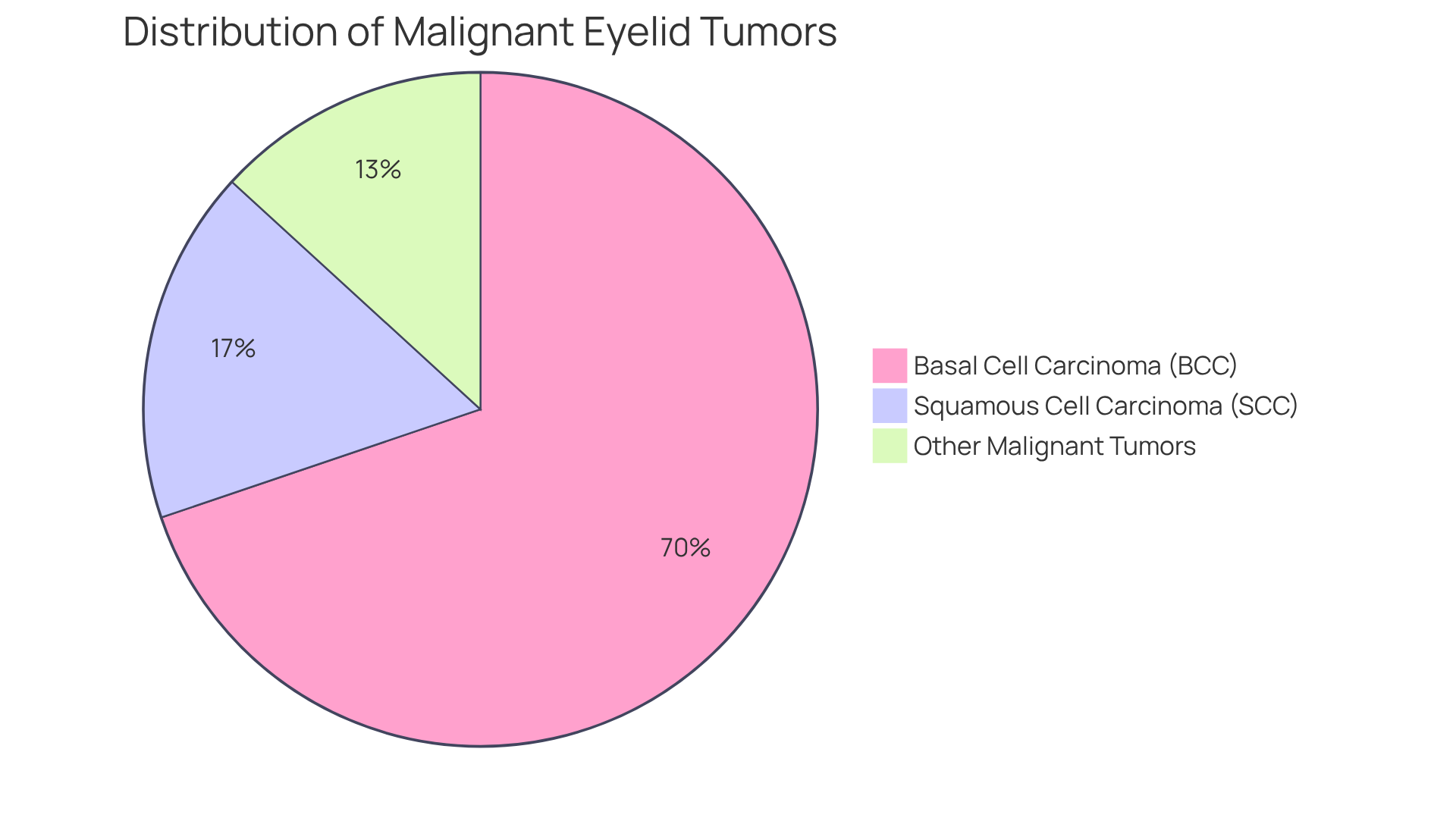
Symptoms of Eyelid Cancer: Recognizing the Warning Signs
Eyelid cancer often presents with distinct symptoms that warrant immediate attention. We understand that noticing a persistent lump on eyelid cancer, along with changes in skin color or texture, or non-healing sores can be concerning. Patients may also experience eyelid swelling, crusting, or bleeding. Recognizing these warning signs early is crucial, as timely intervention can significantly improve treatment outcomes.
Studies indicate that early detection leads to a high cure rate, particularly for basal cell carcinoma, which can reach up to 95%. Oncologist Nusha Ashjaee emphasizes, “Individuals with any history of skin malignancy are at higher risk of developing another skin malignancy,” highlighting the importance of being vigilant about any unusual changes around the eyes. For example, a continuous lump on eyelid cancer in the eye area should not be ignored, as it may indicate the presence of a tumor.
It’s common to feel uncertain, especially when considering the annual incidence rates of eyelid cancer, which are approximately 19.6 cases for every 100,000 men and 13.3 cases for every 100,000 women. This underscores the relevance of awareness and seeking help. Interacting with healthcare providers at the first indication of these symptoms can enable swift diagnosis and care, ultimately improving the likelihood of a positive outcome.
Risk factors such as fair skin and frequent sun exposure should also prompt individuals to be particularly vigilant about any changes. Moreover, we want you to be aware of potential side effects from treatment, which can differ and may influence your decision-making process. Remember, we are here to help you through this process.

Diagnosis of Eyelid Cancer: How It Is Determined
Diagnosing a lump on eyelid cancer can feel overwhelming, but we are here to help you through this process. It involves a meticulous clinical examination conducted by an ophthalmologist, often enhanced by advanced imaging tests such as ultrasound and MRI. These imaging modalities are crucial for visualizing the tumor’s characteristics and extent, helping to differentiate between benign and malignant lesions.
In many cases, a biopsy is performed to definitively verify the presence of a lump on eyelid cancer. This step ensures that the diagnosis is precise and tailored to your specific condition. This multifaceted approach not only facilitates an accurate diagnosis but also informs the most effective treatment strategies, ultimately improving patient outcomes.
Recent trends indicate a growing reliance on imaging tests, reflecting advancements in technology that enhance diagnostic accuracy. As specialists emphasize, incorporating imaging methods is vital for early identification and effective treatment of tumors around the eye. We understand that prompt action can make a significant difference, and we are here to support you every step of the way.
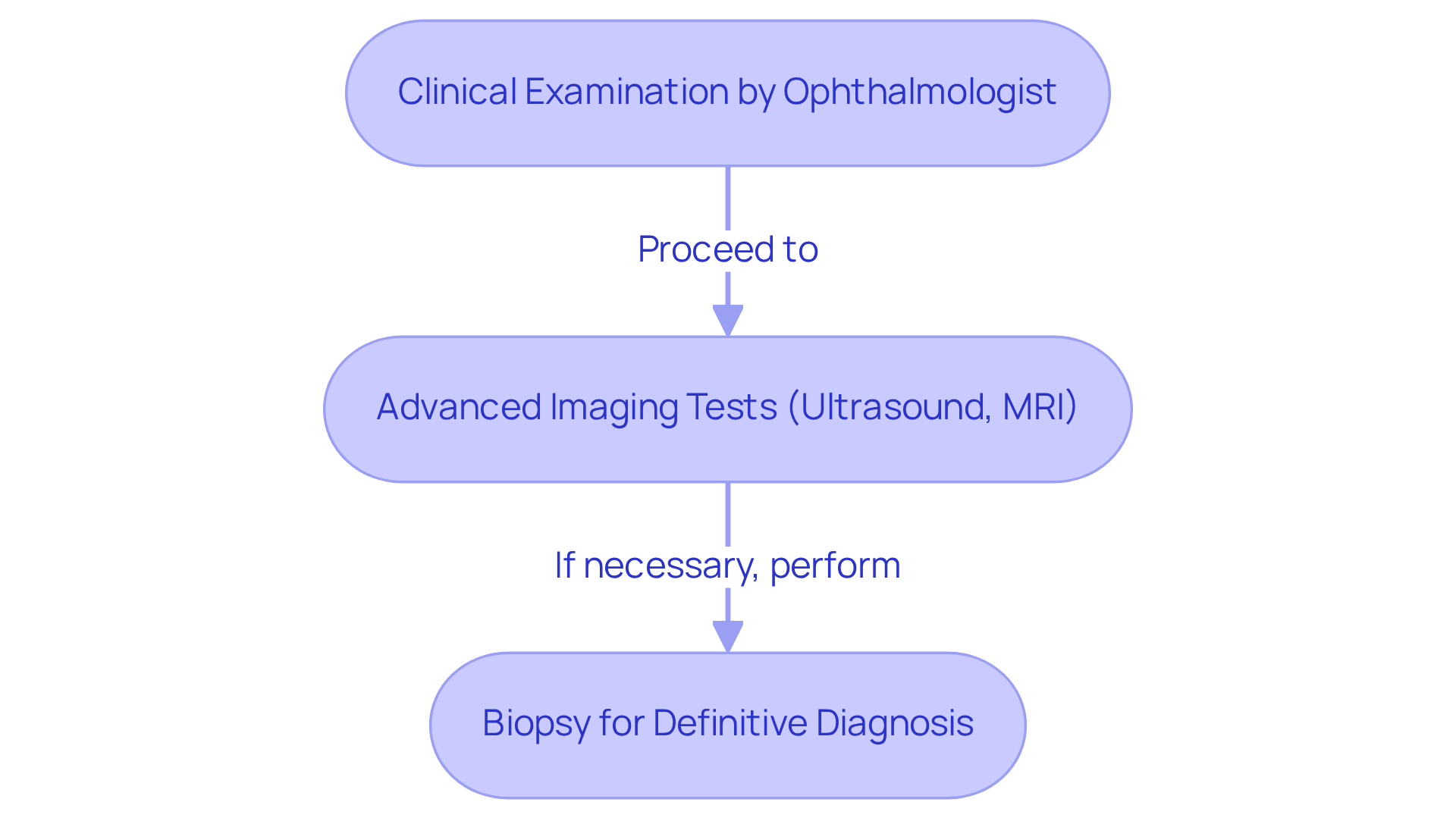
Treatment Options for Eyelid Cancer: What You Need to Know
Treatment for a lump on eyelid cancer often involves surgical excision, with Mohs micrographic surgery (MMS) being a preferred method due to its high precision and effectiveness. We understand that facing a cancer diagnosis can be overwhelming, and this technique allows for the meticulous removal of cancerous tissue while preserving surrounding healthy skin, which is crucial for both cosmetic and functional outcomes. Studies indicate that MMS offers a significantly lower risk of recurrence compared to conventional excision, particularly in high-risk cases.
For individuals who may not be suitable for surgery, options like radiation therapy or topical chemotherapy can be viable alternatives, especially for non-surgical candidates. The selection of care is influenced by factors such as the tumor’s type, size, and location, along with the individual’s overall health. It’s common to feel uncertain about these choices, but recent data indicate that the 5-year disease-specific survival rate for individuals treated for squamous cell carcinoma (SCC) is approximately 86%. This statistic emphasizes the effectiveness of these treatment modalities.
Moreover, the cure rates for non-melanoma skin tumors treated with MMS range from 97% to 99.8%, underscoring its significance as a top choice in managing conditions like a lump on eyelid cancer. We want to reassure you that surgeons emphasize that MMS not only improves survival rates but also enhances patient satisfaction due to better cosmetic results. As advancements in treatment continue, the combination of MMS and radiation therapy remains crucial in effectively addressing tumors of the eye. Remember, we are here to help you through this process and support you every step of the way.
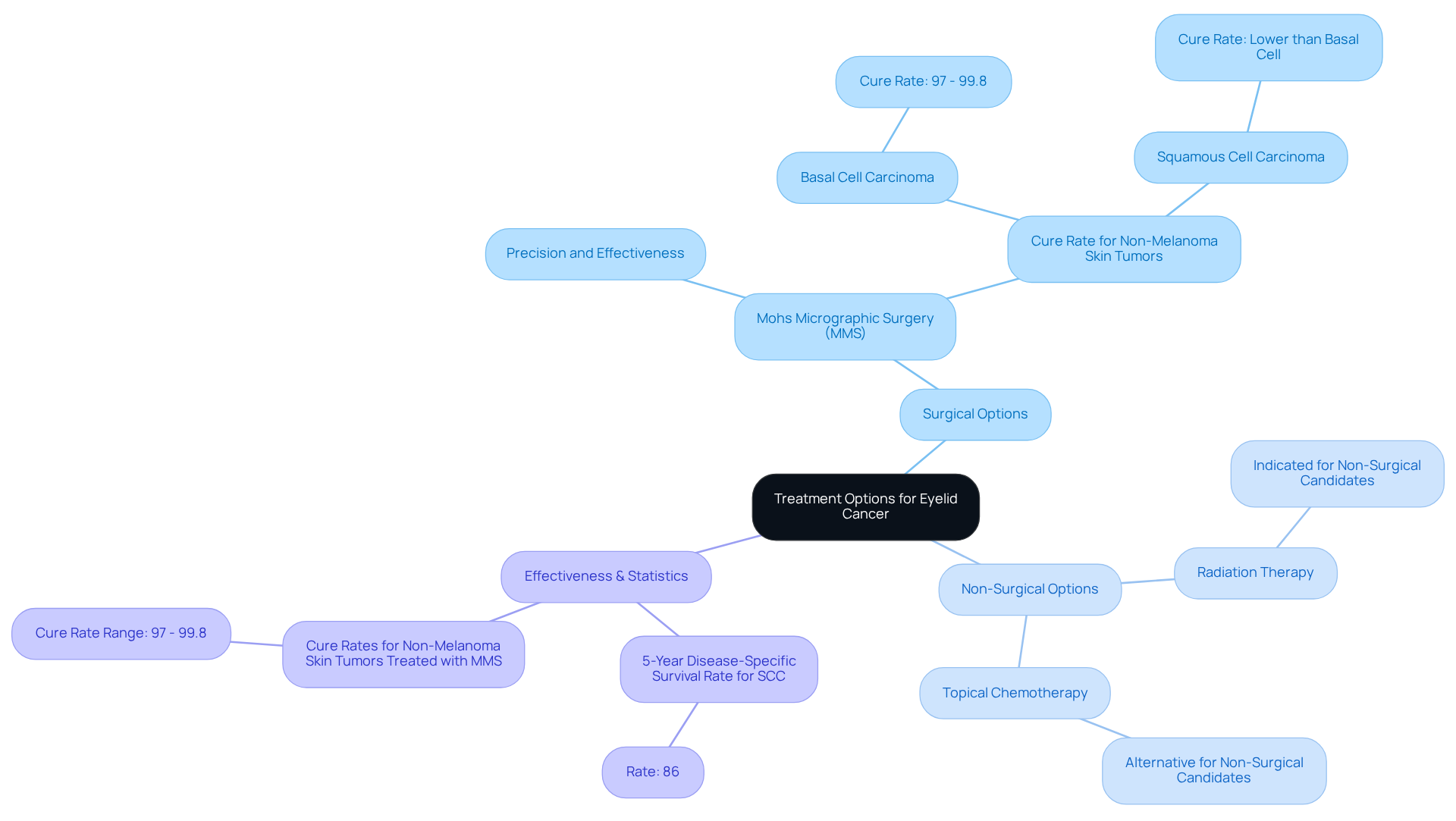
Post-Operative Care for Eyelid Cancer Surgery: Ensuring a Smooth Recovery
Post-operative care after surgery for cancer in the eye region is vital for encouraging optimal healing and minimizing complications. We understand that this can be a challenging time, and patients should adhere to specific guidelines, such as:
- Keeping the surgical area clean and dry
- Applying cold compresses to alleviate swelling
- Refraining from strenuous activities during the designated recovery period
Common post-operative complications can include:
- Ectropion
- Corneal epithelial disorders
- Graft rejection
Studies indicate that postoperative complications were observed in 12 out of 23 upper eyelid reconstructions (52%), including entropion in eight cases and corneal epithelial disorder in four. Furthermore, graft rejection occurred in three individuals, accounting for 9% of all complications.
Regular follow-up appointments are essential. These visits allow healthcare providers to monitor recovery progress and address any emerging concerns. We emphasize the importance of these appointments, as they enable timely interventions if complications arise. For example, a study highlighted that meticulous surgical planning can greatly reduce the occurrence of post-operative complications, reinforcing the need for individuals to stay alert during their recovery.
To further support your recovery, we encourage you to:
- Engage in gentle eye exercises as advised by your healthcare team
- Maintain a balanced diet rich in vitamins
- Stay hydrated
Sharing experiences from others who have gone through similar procedures can also offer valuable insights; many mention that closely following their surgeon’s post-operative instructions aided in a smoother recovery process. By prioritizing these practices, you can enhance your healing journey and improve your overall results after eye surgery.
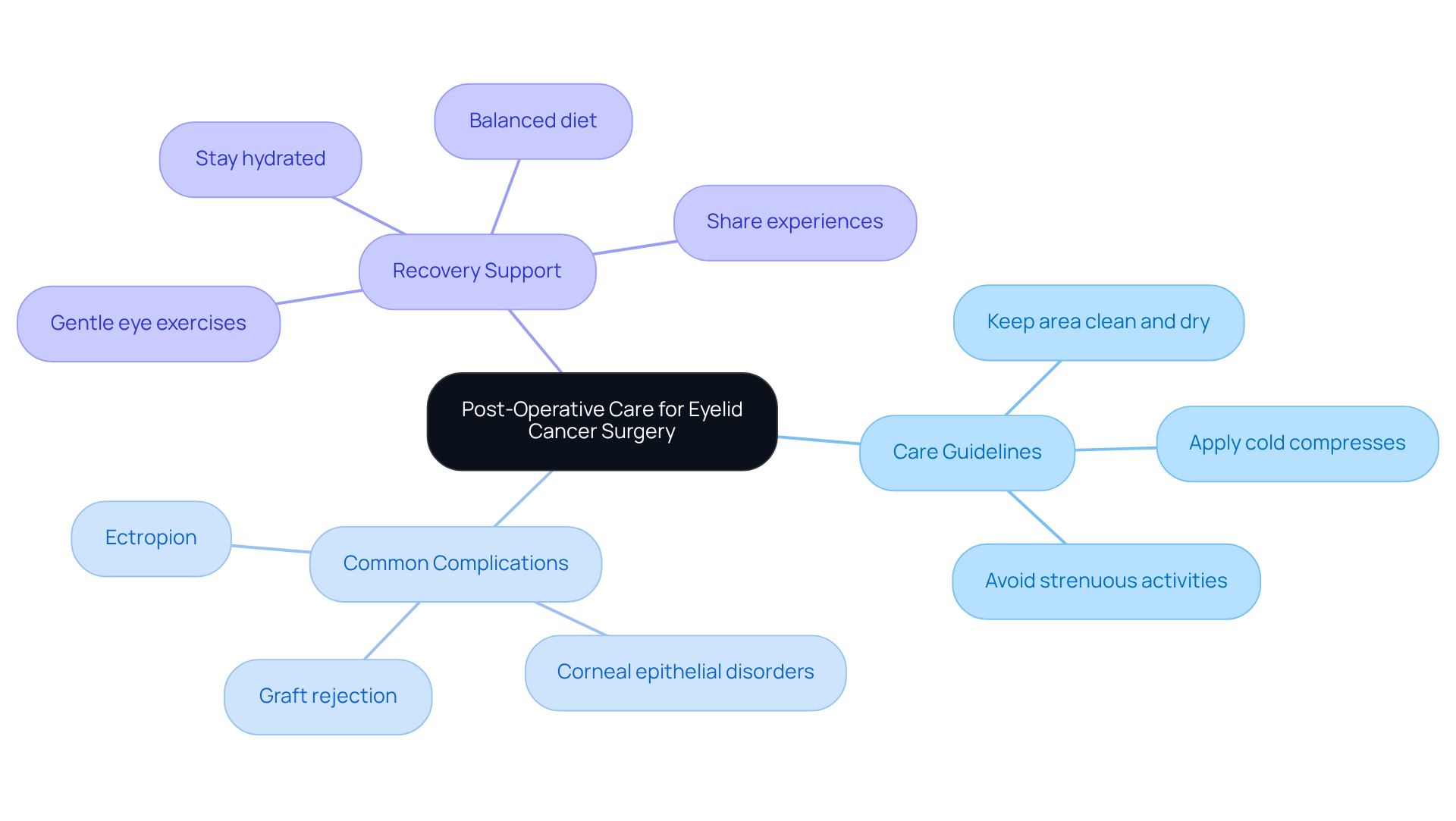
Complications of Eyelid Cancer: Understanding the Risks
Complications arising from lid malignancy and its treatment can encompass a range of issues, such as infection, scarring, and alterations in lid function, including ectropion, which has been observed in 34% of cases. We understand that the risk of recurrence can be concerning, and it varies significantly depending on the tumor type.
- Basal cell carcinoma (BCC) is the most prevalent, accounting for approximately 87.9% of cancers affecting the eye area.
- Recurrence rates for BCC after surgical excision range from 1% to 5% per year, while squamous cell carcinoma (SCC) has a recurrence rate of about 11.1%.
- Extended UV exposure is a primary risk factor for BCC, which is vital for individuals to consider.
It’s common to feel apprehensive about potential complications, particularly with more aggressive tumor types. Surgical techniques, such as Mohs micrographic surgery, are often employed to minimize recurrence risks, achieving cure rates as high as 95% for BCC. However, it’s important to note that the choice of surgical method can influence outcomes.
- For example, direct closure techniques have shown a higher recurrence rate of 76.9% compared to advanced flap and free skin grafting, which have a recurrence rate of only 7.7%.
- Total tumor removal remains the most crucial therapeutic approach for malignant eyelash tumors.
We encourage individuals to engage in open conversations with their healthcare providers about these risks and the management strategies available. As specialists emphasize, understanding the nuances of eyelid tumor management is essential for improving individual outcomes and ensuring effective long-term care. By being informed and proactive, you can navigate the complexities of your treatment and recovery with greater confidence.
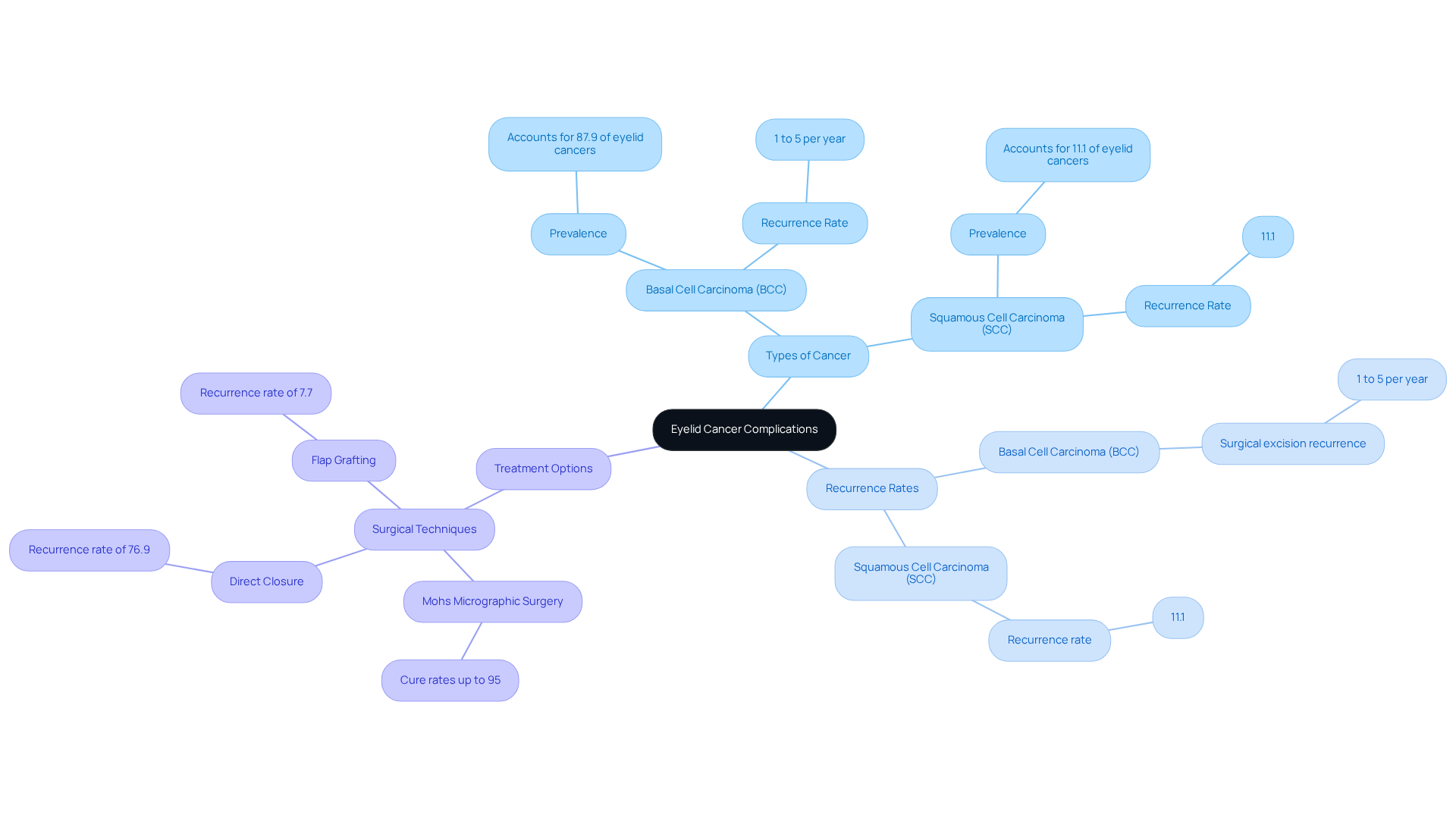
Prognosis for Eyelid Cancer: What to Expect
The outlook for tumors of the eyelid is typically positive, and we understand that this can bring a sense of relief. When these tumors are identified early and managed correctly, the chances of a favorable outcome increase significantly. For instance, basal cell carcinoma has a high cure rate exceeding 95% with timely intervention, which is encouraging news.
However, it’s important to acknowledge that factors such as tumor type, size, and individual health can influence outcomes. We know it’s common to have questions and concerns about how these factors might affect you personally. Regular follow-ups and monitoring are crucial for ensuring long-term success, and we are here to help you through this process. Remember, you’re not alone in this journey; support is available every step of the way.
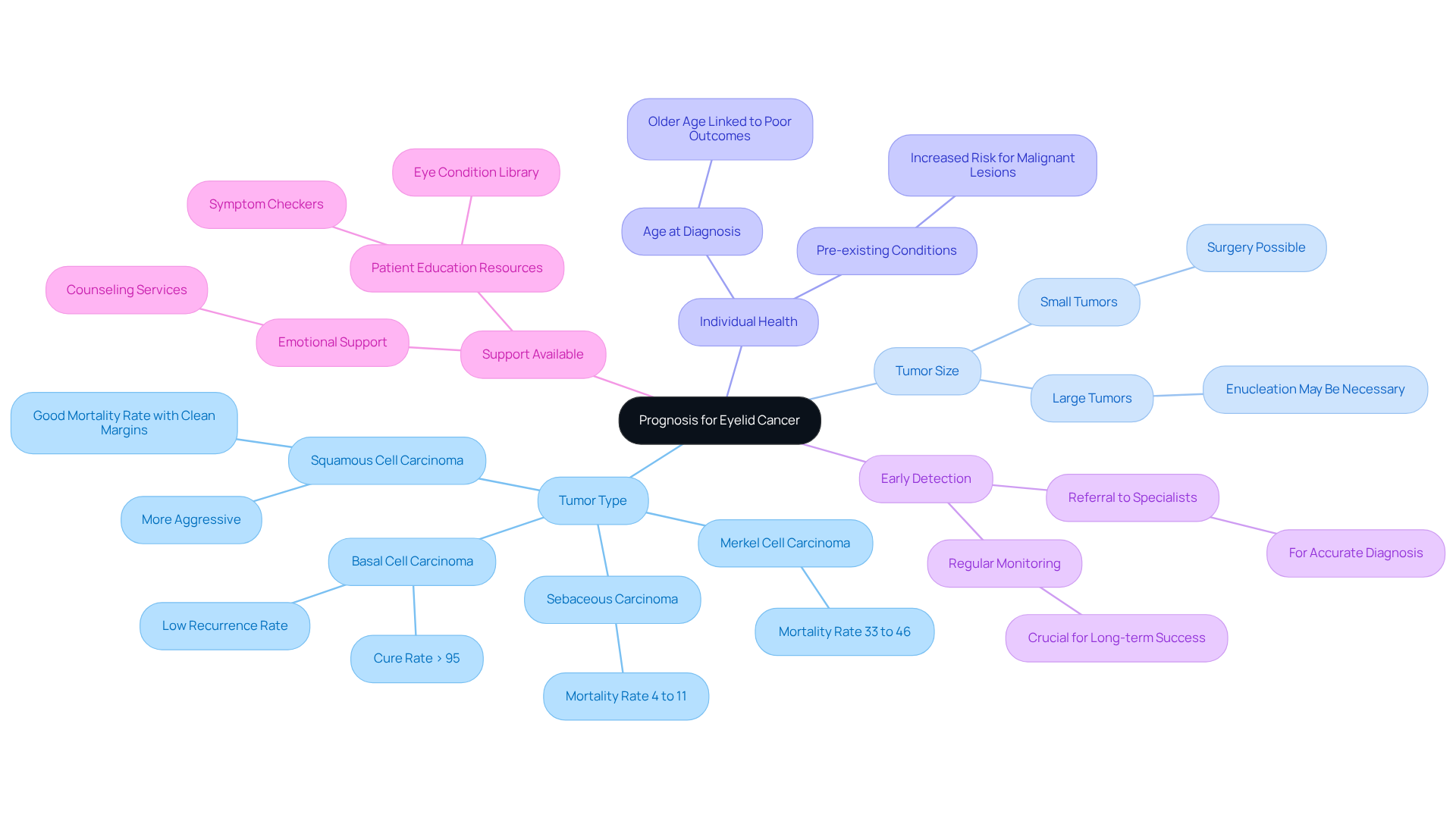
Patient Education on Eyelid Cancer: Empowering Your Journey
Empowering individuals with knowledge about lump on eyelid cancer is essential for effective care. At Northwest Eye, we understand that facing such a diagnosis can be overwhelming. That’s why we are committed to offering a wealth of resources, including educational materials and access to support groups. These resources play a crucial role in boosting individual confidence and fostering a sense of community.
Research indicates that 40.4% of studies reported positive changes in health outcomes following educational interventions. This highlights the effectiveness of health education in navigating health challenges. Moreover, support groups have been shown to greatly enhance individual activation, knowledge, and self-management. It’s common to feel uncertain, but sharing experiences with others can provide reassurance and comfort.
By linking individuals with specialists who can address their questions and concerns, Northwest Eye ensures that you can navigate your diagnosis and care with assurance and clarity. We are here to help you through this process. As one patient advocate noted, ‘Knowledge is power, and being informed about your condition can make all the difference in your treatment journey.
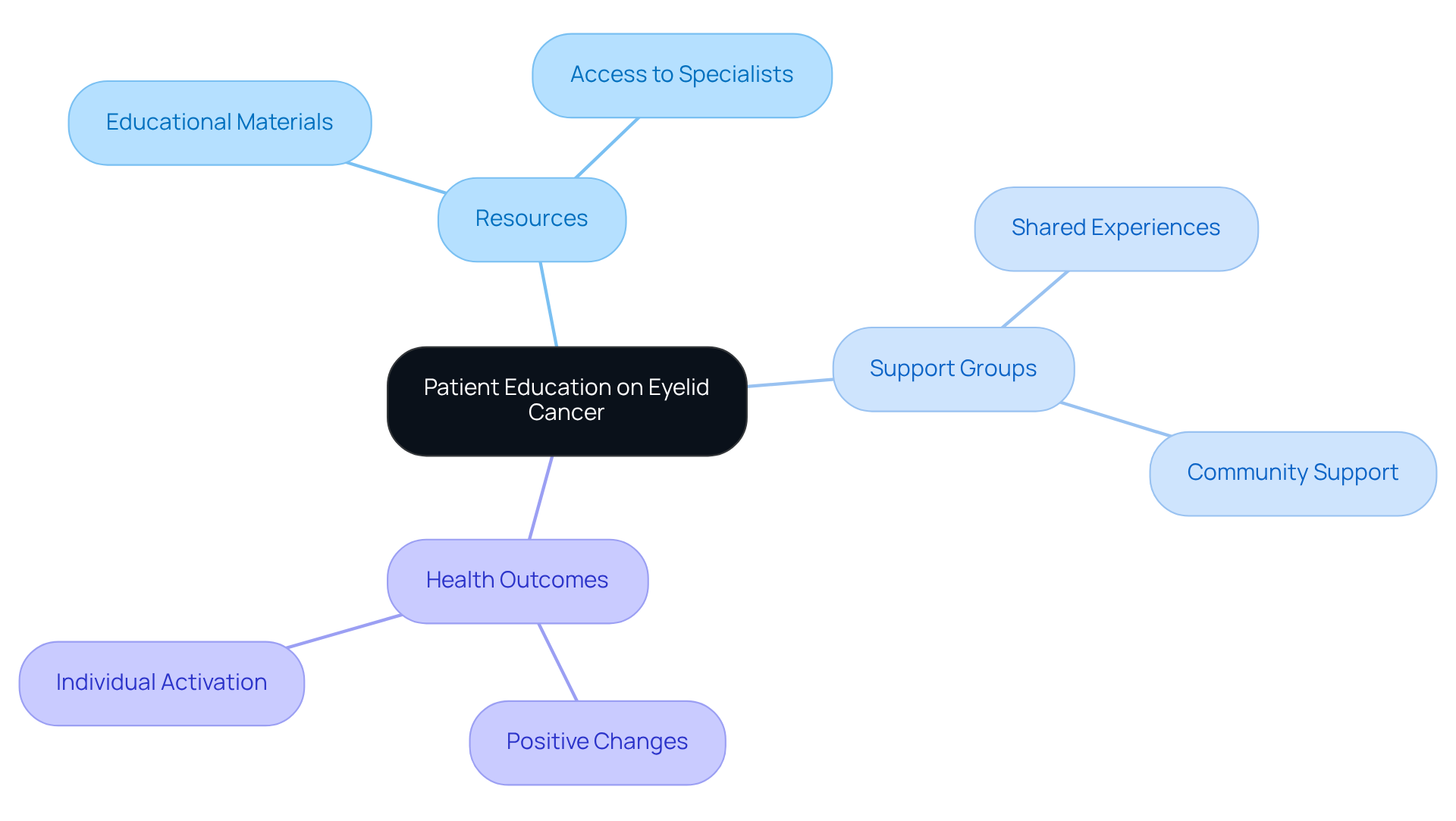
Importance of Regular Eye Exams: Early Detection of Eyelid Cancer
Routine eye examinations are crucial for the early identification of a lump on eyelid cancer. We understand that health concerns can be daunting, but these examinations allow eye care professionals at Northwest Eye to identify suspicious lesions that may indicate malignancy, facilitating timely intervention. Studies show that a considerable percentage of tumors located on the eyelids are identified during regular eye examinations, highlighting their significance in preventive healthcare.
For instance, if you have risk factors such as fair skin or a history of extensive sun exposure, prioritizing annual check-ups can help catch potential issues early. Frequent signs of tumors on the eyelid may include alterations in the appearance of the area, such as a lump on eyelid cancer, which should be assessed by a specialist. Ophthalmologists emphasize that early detection through regular exams can lead to better treatment outcomes and minimize complications.
In fact, patients who undergo consistent eye exams demonstrate improved management of a lump on eyelid cancer, with higher rates of successful interventions. Therefore, scheduling annual eye exams is a proactive step in safeguarding your eye health and ensuring any emerging concerns are addressed promptly.
To empower yourself with knowledge about your eye health, consider exploring the resources available through the Be Eye Wise initiative. We are here to help you through this process, so take action today by contacting your eye care provider at Northwest Eye to schedule your next appointment.

Conclusion
Recognizing the critical importance of early detection in managing eyelid cancer, we understand that this diagnosis can be overwhelming. This article sheds light on essential insights that can empower you during this challenging time. By understanding the types of eyelid tumors, their symptoms, and the diagnostic processes, you can take proactive steps toward effective care. The comprehensive approach offered by Northwest Eye, coupled with the Be Eye Wise initiative, underscores our commitment to your education and optimal treatment outcomes.
Key points discussed include:
- The prevalence of different tumor types
- The significance of recognizing warning signs
- The effectiveness of early intervention
With a high cure rate for basal cell carcinoma and advancements in surgical techniques, timely diagnosis can lead to favorable outcomes. Moreover, we emphasize the necessity of regular eye exams as a preventive measure, ensuring that potential issues are identified and addressed promptly.
In conclusion, awareness and education are paramount in navigating the complexities of eyelid cancer. We encourage you to prioritize your eye health by scheduling regular check-ups and staying informed about the symptoms and treatment options available. By taking these proactive steps, you can significantly enhance your chances of successful intervention and recovery, reinforcing the message that knowledge truly is power in your journey toward health and well-being.
Frequently Asked Questions
What services does Northwest Eye provide for eyelid cancer?
Northwest Eye offers a comprehensive range of eye care services, including specialized care for patients with a lump on eyelid cancer. They utilize advanced methods and technology to ensure optimal outcomes.
What is the Be Eye Wise initiative?
The Be Eye Wise initiative emphasizes the importance of understanding eye health and care options. It aims to educate patients about advancements in the treatment of eyelid malignancy and empower them to make informed choices regarding their well-being.
What types of eyelid tumors are recognized at Northwest Eye?
Eyelid tumors are classified into benign and malignant types. The most prevalent malignant type is basal cell carcinoma (BCC), followed by squamous cell carcinoma (SCC). Other less common malignancies include sebaceous gland carcinoma and melanoma.
What are the statistics regarding basal cell carcinoma (BCC)?
BCC accounts for approximately 69.8% of malignant eyelid tumors. The treatment outcomes for BCC are promising, with a successful cure rate of around 95% following surgical excision, although the recurrence rate is between 1% to 5% per year.
How does squamous cell carcinoma (SCC) differ from BCC?
SCC is more aggressive than BCC, with an overall five-year survival rate of about 58.3%. This emphasizes the importance of vigilant monitoring and timely intervention for SCC.
What are common symptoms of eyelid cancer?
Common symptoms include a persistent lump on the eyelid, changes in skin color or texture, non-healing sores, eyelid swelling, crusting, or bleeding. Early recognition of these symptoms is crucial for effective treatment.
What is the annual incidence rate of eyelid cancer?
The annual incidence rates of eyelid cancer are approximately 19.6 cases for every 100,000 men and 13.3 cases for every 100,000 women.
What risk factors should individuals be aware of regarding eyelid cancer?
Risk factors include having fair skin and frequent sun exposure, which may increase the likelihood of developing eyelid cancer.
How can early detection impact treatment outcomes for eyelid cancer?
Early detection is linked to a high cure rate, particularly for basal cell carcinoma, which can reach up to 95%. Prompt interaction with healthcare providers at the first signs of symptoms can lead to swift diagnosis and improved outcomes.






